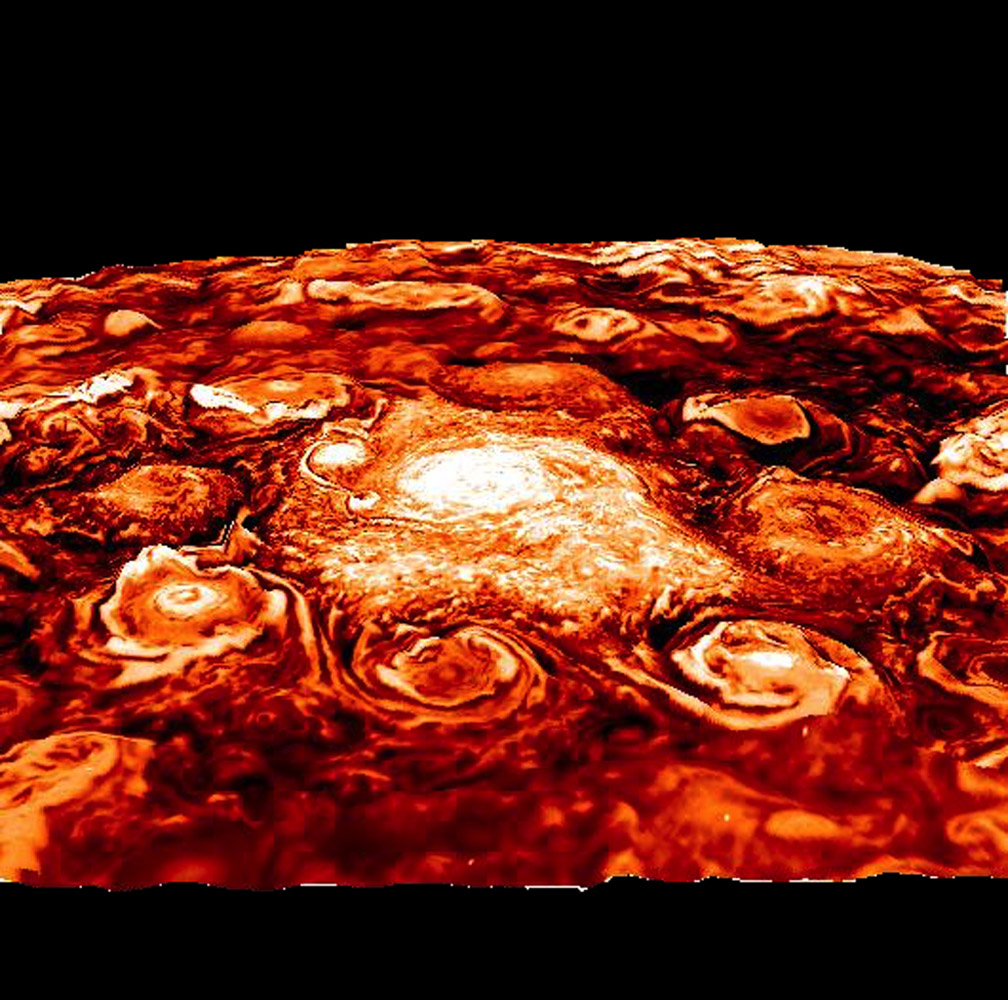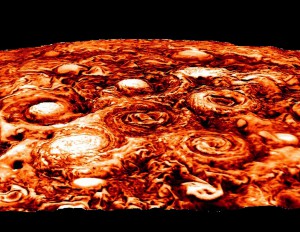Say what? This is the storm-tossed north pole of Jupiter?
Posted on Categories Discover Magazine

NASA’s Juno mission to Jupiter has produced some wild imagery of the giant planet, showing massive swirling cyclones with a 3D effect
This computer-generated image is based on an infrared image of Jupiter’s north polar region that was acquired on February 2, 2017, by the Jovian Infrared Auroral Mapper (JIRAM) instrument aboard Juno during the spacecraft’s fourth pass over Jupiter. (Source: NASA/JPL-Caltech/SwRI/ASI/INAF/JIRAM)
When I first glanced at the image above, I thought I was looking at the surface of the Sun. But no, these really are mega cyclones swirling with winds up to 220 miles per hour around Jupiter’s north and south poles, as seen by NASA’s Juno spacecraft.
According to new research, they are long-lasting features unlike anything else seen before in our solar system.
A wealth of new findings from Juno about the giant gaseous planet have been published this week in the journal Nature. They’ve also been featured in a release by NASA.
As seen in the image above, Jupiter’s north pole features a dominating central cyclone surrounded by eight others with diameters as large as 2,900 miles. This means the largest surrounding cyclone is big enough to cover much of North America.
Juno carries an instrument that views Jupiter in the infrared part of the electromagnetic spectrum. It can probe the planet’s atmosphere down to a depth of 30 to 45 miles, providing new insights into weather phenomena extending well beneath the cloud tops.
Data acquired by the instrument — the Jovian Infrared Auroral Mapper, or JIRAM — were used to create the computer-generated image, enhanced with a three-dimensional effect showing the structure of the storms. (For more on how it was done, see this explanation from NASA.)

Computer-generated image of Jupiter’s south pole based on Juno data. (Source: NASA/JPL-Caltech/SwRI/ASI/INAF/JIRAM)
The mega cyclone at Jupiter’s south pole is surrounded by five cyclones. with diameters between 3,500 to 4,300 miles. The image at right shows what they look like. It was created with JIRAM data using the same technique.
The cyclones at both poles are surprising in a number of ways. Here’s one of them, as explained by NASA
Almost all the polar cyclones (at both poles), are so densely packed that their spiral arms come in contact with adjacent cyclones. However, as tightly spaced as the cyclones are, they have remained distinct, with individual morphologies over the seven months of observations detailed in the [scientific] paper.
“The question is, why do they not merge?” asks Alberto Adriani, a Juno co-investigator, quoted in NASA’s release. “We know with Cassini data that Saturn has a single cyclonic vortex at each pole. We are beginning to realize that not all gas giants are created equal.”
